The Benchmark Dreadnought Lives Again in the Martin D-28 Authentic 1937
A fraction of the price of a 1937 D-28. Only the rosewood has been changed to protect the innocent environment.
Specifications include: hot hide glue construction throughout; Dreadnought body size; solid Madagascar rosewood back and sides; solid Adirondack spruce top; Authentic style scalloped, forward-shifted Adirondack braces in the 1937 position, with tucked bridge plate; solid mahogany neck with T-bar neck reinforcement, 1-3/4” vintage V neck; ebony fingerboard and bridge with 2-5/16” string spacing; bone saddle and nut; open-back Waverly tuners; Vintage Style 28 appointments including herringbone top trim and long pattern diamonds and squares fingerboard markers in solid Abalone pearl.
Living Musical History
When replicating a rare and highly coveted historical relic, where does one begin? When it came time to make an exacting reproduction of a pre-war D-28, the folks at C.F. Martin happened to have one residing in their own museum, which was made in 1937. And it provided a wealth of information so that it could be reborn as the 2014 D-28 Authentic 1937.
The D-28 is the most copied guitar in history, and the 1937 D-28 is the one to which all others are compared. So it is a tall order to make a new guitar and claim it is, at least in most respects, as close as one may come to the original article. Martin has succeeded wonderfully in this endeavor, building a time capsule of a rosewood dreadnought eager to begin its own sonic journey toward musical immortality. While it remains impossible to build-in 77 years of seasoning, the envied owner of a new D-28 A 1937 will be afforded the privilege of breaking in the fledgling tone woods and ultra-thin nitrocellulose finish, to coax out more and more of the guitar’s rich, round rosewood lows, punchy Adirondack mids, and pure, ringing trebles that signify the classic Martin sound.
The 1937 Sweet Spot
Martin introduced the first modern 14-fret flattop acoustic guitars in their 1930 catalog, but the first 14-fret dreadnought didn’t appear until 1934. The design was tweaked over several years, most noticeably in the width and shape of the neck. Martin had narrowed the necks from 1-7/8” at the nut to 1-3/4” when they began making 14-fret guitars, but they also began making necks thicker and more massive. Across 1935-36 Martins were offered with what has come down to us as the “baseball bat neck.” But in 1937, the necks began to lose some of their girth, especially down in the first positions, where the wrist must bend in the most unnatural angles.
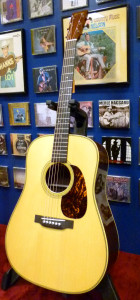 The bracing was also tweaked across the 1930s, and in 1938 they changed the position of the main X brace supporting the top, moving it almost an inch farther away from the sound hole, from 1” to 1-7/8”. Although conjecture, it is believed the change was related to the fact players were starting to use heavier gauge strings. In response, Martin moved the center of the X brace closer to the bridge plate to shore up support against the extra stress put upon the bridge.
The bracing was also tweaked across the 1930s, and in 1938 they changed the position of the main X brace supporting the top, moving it almost an inch farther away from the sound hole, from 1” to 1-7/8”. Although conjecture, it is believed the change was related to the fact players were starting to use heavier gauge strings. In response, Martin moved the center of the X brace closer to the bridge plate to shore up support against the extra stress put upon the bridge.
When they changed position of the braces, they altered the sound these pre-war Martins made. Rear-shifted bracing brings greater definition to the bottom end, while forward-shifted bracing results in a pronounced and echoing resonance, particularly in the lowest part of the undertone that swells out beneath the bass notes to influence the mid-range, and trebles as well. So, the 1937 D-28 is considered the benchmark dreadnought, as it provides the guitarist with forward-shifted bracing along with arguably the most comfortable 1-3/4” neck found on a pre-war dreadnought.
Martin moved to a 1-11/16” neck in 1939. And while there is a lot to like about dreadnoughts with the rear-shifted bracing used from 1938 well into the 1950s, and those with the modern bracing position that appeared by 1960, which is 3/8” farther forward, many people covet the extra rumble and resonance heard in guitars made with the original forward-shifted positioning. So much so, Martin brought back forward-shifted bracing in the modern era, featuring it on many models from their Vintage Series, Golden Era and Marquis Series, as well as the D-18 and D-42 of the Standard Series. But there are significant differences found in the Authentic Series bracing, as well as many other aspects that set the Authentics apart from most other modern-day guitars.
Newly Old School
As with all the guitars used to create Martin’s revamped Authentic Series, the museum’s 1937 D-28 was subjected to the most intimate investigation yet done to mine the magic of the pre-war Martins, and uncover the secrets of those master craftsmen working in the years between the world wars. This included having the old guitar X-rayed and sent to the Smithsonian Institute to be examined under their CAT Scan machine.
All the Authentics feature braces shaped like they were in the old days, with the bridge plate “tucked” under the X brace, which must have groves carved into the underside of each strut to accommodate it, a practice abandoned at Martin in the late 1940s. And each guitar is made with traditional hot hide glue, requiring considerably more effort to prepare and store than modern glues. Repeated testing and experience has shown that other things being equal, hide glue does make a difference in the sound of the guitar. It is true, not everyone says they can hear the difference. But many people say they cannot hear the difference caused by a bolt-on neck vs. a traditional dovetail neck, or the differences between species of spruce soundboards, or the difference between rosewood and mahogany.
The Authentics are the first modern Martins to feature hide glue construction since the mid-1960s. It has since appeared on some other special editions, and is now a pricey Custom Shop option.
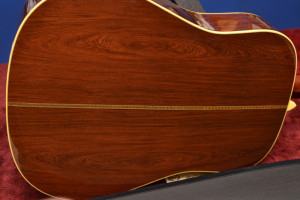 |
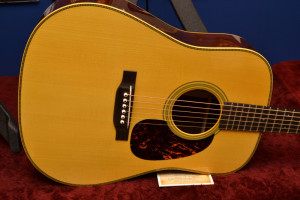 |
 |
Photos: Maury’s Music
Madagascar Rosewood
The one specification that sets the new D-28 Authentic 1937 apart from its pre-war counterpart is the fact it has Madagascar rosewood for the back and sides. The original has Brazilian rosewood, a protected species Martin stopped using in 1969, and which has only appeared on some later high-end models. The earlier D-28 Authentic from 2006 was made out of Brazilian rosewood, and had a list price of $39,999. Apparently they completed 50 of them.
Brazilian rosewood has great visual beauty, and is unmatched in its tonal pallet of darkness and brightness, dryness and richness, and especially when it comes to harmonic complexity. But among those species vying as pretender to the tonewood throne, Madagascar rosewood is lovely to look upon, with coloring and grain patterns reminiscent of Brazilian, and there is considerable crossover between the tonal properties of the two related woods. While Madagascar has its own pretty chime, when compared directly to Brazilian, it is not quite so complex overall, and its harmonic spectrum is centered more in the mid-range than the low-mids. Still, the darkest, richest Madagascar reaches well beyond the chimiest, driest Brazilian. And when matched to an excellent piece of Adirondack spruce, it rings like crystal up top, and has marvelous, woody definition in the bottom end.
But the most important reason they chose to use Madagascar rosewood on the new Authentics can be found in the end price of the guitar. For very little difference in tone or looks, the old D-28 Authentic 1937 is nearly 5 times the price of 2014 version. And this new one has many significant features that make it even more authentic than the 2007 rendition.
~:~
~:~
In The Details
The spruce top on a new Authentic is sanded to the same thickness found on Martin guitars of the 1930s, and so is the rosewood. The finish is thinner as well. Fred Greene, Martin’s Vice President of Manufacturing, said the initial finish applied to pre-war guitars would have been thicker than it appears today, but it has shrunk over the decades. Since they now have the technology to achieve thinner finishing, that on the Authentics is some 40% thinner than what ends up on on other modern Martins. This should give the guitar a head start on the playing-in process, as the tonewood will “breathe” more easily and be that much more flexible from the get go.
Just as the tonewoods and finish are thinner, as is the back’s inside center strip, so too are the ebony fingerboard and the wings of the ebony bridge, and both help transfer physical energy from the vibrating strings to that thin spruce soundboard. Likewise the headstock is thinned to pre-war specifications, and the neck is carved to be as identical as possible to the shape and feel of the museum piece it is based upon. It truly is closer in its dimension than previous attempts to replicate pre-war Martins.
Although all Authentics have the tucked bridge plate, and bracing that mimics the size and position of the particular pre-war year they are aiming at, only those debuting in 2013 and now 2014 have a bridge plate thinned and shaped in the smallest detail to simulate the very one on the specific Martin Museum guitar they are attempting to replicate. From the size and thickness of the grained ivoroid binding, to the Vintage Style 28 purfling and rosette, to the solid Abalone shell used for the fret markers, this is perhaps the most accurate reproduction of a pre-1938 D-28 yet created, and certainly the best example sold well below $10,000.
Excellence and Potential
As with the Authentics that debuted in 2013, I came to the D-28 Authentic 1937 wondering, how could it possibly match the finicky expectations of those most desirous of a pre-war Martin clone? Even with the ridiculously affordable price tag, every molecule on this guitar will be weighed against the dreams and wishful thinking built up over the months, and in some cases years of anticipation of just such an instrument.
Was I blown away by the new guitar on the first strum? Not nearly as much as I was by the D-28 Authentic 1941 I played a year ago. The quality of that guitar was a surprise, even for me. But I have been around quite a few Authentics and other hide glue, thin-finish Martins on a weekly basis since then, and am somewhat jaded to their overall excellence.
What I heard was an excellent rosewood dreadnought, already with a great deal of personality despite its brand new and very stiff Adirondack spruce top, even if it was obvious just how much tone was aching to get out, once the fibers and resins in the wood start to break in, and the top starts to open up.
At present it has clear and ringing fundamentals, just as expected, and the forward-shifted bracing provides a fat, tuba-like oom-pa when playing fingerstyle with an alternating bass. But the top is so new that one can hear but the promise in that pretty voice, when it comes to flatpicking or sweeping through a full chord, or wringing out the resonance in a sustained note. The pistol shot Adirondack mids are there, and pop out when under optimal attack for the top’s current stiffness. The trebles glint and ring with purity and good body. The bass notes are tight and somewhat subdued out front, while provoking all kinds of thick undertone resonance.
In other words, it is as it should be in its first weeks of existence. But it will not be long before a thick pick and a heavy hand bring the roar from out of the furnace, or the reflective harmonics start to glow more with a lighter touch then they do right now.
Do not misunderstand me; this is a great guitar right out of the box. I just know how much greater it will become as time goes by. It is like a Kentucky thoroughbred yet to run its first race. Or perhaps a Ferrari barely off the lot. You can push it over 5000 rpm on that first 100 miles if you want, but you will experience less friction if you don’t.
As with most soundboards of new Adirondack spruce, attempts to get it to come out of its shell by digging in and attacking it sort of skip off the surface. Having taut medium-gauge strings only exasperates the situation, but ultimately they should help when it comes to the whole lot of shaken the top will need to forget that it was once a tree, and realize it is now a songbird. I would have been quite happy to take the guitar home and enjoy that just-out-of-the-nest awakening.
I played the guitar again four days later, and the day after that. On the day I recorded the video, I played it in a hurry, moments after it was taken from its case and restrung. During the other sessions, there were several people passing it around so it had plenty of time to wake up for the day, and that helped get a better feel for where the voice is now.
It sounds lovely, if tight, warm and full bodied where it should be, and bright where it is most thrilling. People are going to be extremely happy with the D-28 Authentic 1937, even if some will feel it falls short of what they imagined, while others now rue having to choose between the rear-shifted bracing on the D-28 A 1941, with its sleek 1-11/16″ neck, or this forward-shifted version with its comfortable yet meatier 1-3/4″ neck.
As comparisons go, this guitar reminds me more of the 2007 D-28 Authentic than I ever expected it to, as those guitars also came with very stiff tops of high quality grain. It has the same kind of inherent righteousness deep down inside the voice, and the same promise of greatness. I can only imagine how the extra thin finish and woods on this 2014 version will pay off in terms of resonance and responsiveness as time goes on. And since each handmade guitar will come with a unique top and set of tonewoods, some will get there sooner than others, but each will be trained to develop a voice influenced toward the style of playing of the guitarist doing the training. And that is something that often goes unmentioned when discussing the differences between a decent, run of the mill acoustic guitar, and an exquisite top-self example of the luthier’s craft.
Old Timey Comforts
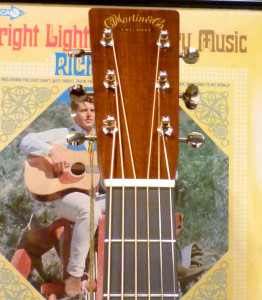 When it comes to playability and comfort, as my aging football injury deteriorates through the years, I have become highly sensitive to necks. This guitar has simply the best modern version of a vintage 1-3/4” long-scale neck I have found. It does have substantial girth in the uppermost positions, with a noticeable V. But it is not a particularly sharp V, and as the hand moves down toward the middle of the neck the carving grows sleeker and the V lessens, until it becomes basically a low non-V profile where the hand needs to bend at its most severe angles, when forming a partial F chord or playing the fully barred B-flat, for example.
When it comes to playability and comfort, as my aging football injury deteriorates through the years, I have become highly sensitive to necks. This guitar has simply the best modern version of a vintage 1-3/4” long-scale neck I have found. It does have substantial girth in the uppermost positions, with a noticeable V. But it is not a particularly sharp V, and as the hand moves down toward the middle of the neck the carving grows sleeker and the V lessens, until it becomes basically a low non-V profile where the hand needs to bend at its most severe angles, when forming a partial F chord or playing the fully barred B-flat, for example.
That vanishing V in the first positions is not on all pre-war Martins, but it is found on a great many of them going back at least to 1930. Yet it is a feature Martin failed to recreate on any of their modern reproductions among the various vintage-esque series, or the many limited editions, like the OM-28 Perry Bechtel or Custom 15. That is, until now. It instantly became my favorite feature on this new model.
My least favorite feature is the aging toner used to make the guitar appear more like a vintage guitar. Martin uses various coloration in their toners, and many people bemoan the “pumpkin orange” tops on the Vintage Series, even if they are in fact dead ringers for many actual vintage Martins. In the case of the Authentics, they do aim to recreate a color for the spruce that fits the look of the guitar they are trying to recreate, and in this case it is less orange than the Vintage Series, yet it is darker than I recall seeing on the GEs.
But on the new Authentics, they also apply it to the whole body of the guitar, which yellows the ivoroid binding considerably. In effect, it is sort of “relicing” the guitar, without going to the extent of fake lacquer checking and finish wear and tear, to which other manufacturers now subject their electric guitar reissues. Basically, this guitar is a relic whose owner took really good care to keep it unblemished, I suppose.
I can understand why they do not want the butter-white color of new Adirondack, but I am sure I am not alone in wishing they had lightened up the current Authentic toner a bit. But it is hard to apply much of a penalty when scoring such a spectacular musical instrument.
Really, most people will not even notice the toner a week after buying the guitar. I know I would also not notice how nice the neck feels either. That is the way necks should be!
And that is one man’s word on…
Martin D-28 Authentic 1937
List Price: $8,499
Call your Martin dealer to find out the real price.
Read More About…
Martin Model Designations and Differences
Official Spec Sheet
Construction: Mahogany Blocks/Dovetail Neck Joint – Hide Glue
Body Size: D-14 Fret
Top: Solid Adirondack Spruce
Rosette: Style 28
Top Bracing Pattern: Standard ”X” Scalloped (Authentic Style) Circa 1937 – Forward Shifted
Top Braces: Solid Adirondack Spruce 5/16”
Back Material: Solid Madagascar Rosewood
Back Purfling: 28 Style Zig-Zag (Authentic)
Side Material: Solid Madagascar Rosewood
Endpiece: Grained Ivoroid in a Narrow 1937 Shape
Endpiece Inlay: Black/White Boltaron
Binding: Grained Ivoroid
Top Inlay Style: Bold Herringbone
Side Inlay: none
Back Inlay: Black/White Boltaron
Neck Material: Solid Genuine Mahogany
Neck Shape: Authentic 1937 Barrel & Heel
Nut Material: Bone
Headstock: Solid/Diamond/1937 Taper
Headplate: Solid Madagascar Rosewood
Heelcap: Grained Ivoroid
Fingerboard Material: Solid Black Ebony
Scale Length: 25.4”
Number of Frets Clear: 14
Number of Frets Total: 20
Fingerboard Width at Nut: 1-3/4”
Fingerboard Width at 12th Fret: 2-1/4”
Fingerboard Position Inlays: Diamonds & Squares – Long Pattern 1937
Fingerboard Binding: none
Finish Back & Sides: Polished Gloss w/ Aging Toner
Finish Top: Polished Gloss w/ Aging Toner
Finish Neck: Polished Gloss w/ Aging Toner
Bridge Material: Solid Black Ebony
Bridge Style: Authentic Style Belly w/ Long Saddle
Bridge String Spacing: 2-5/16”
Saddle: 16” Radius/Long Bone
Tuning Machines: Waverly Nickel w/ Butterbean Knobs
Recommended Strings: Martin SP Lifespan Phosphor Bronze Medium Gauge (MSP7200)
Bridge & End Pins: Ivory Colored Poly w/ Black Dots
Pickguard: Delmar Tortoise Color
Case: 545V Harptone
Interior Label: none
Electronics: none
Other Options: Available left-handed at no additional charge
Other Comments: All prices & specifications are subject to change without notice
~:~
~:~
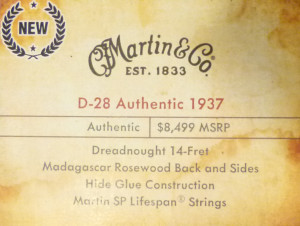
I have a 2011 Merrill C-28 that was built to exact specifications of a 1937 Martin D-28 including old growth straight grain Brazilian rosewood. I love my Merrill, but my Martin Authentic 1937 gets all the play time.
One Man
I’ve been thinking about getting one but the only thing that is stopping me is it not having an adjustable trust rod. i worry about the neck being a little off and there is no way fix it. I know that Martin did not start using them until the late 80’s. I live in Louisiana and the humidity always wrecks havoc on my action but I never have to worry about my guitars getting too dry. What do you think. Am I worrying about nothing.
Sorry it took me so long to respond, Scott. This ended up in my spam folder for some reason.
So many people are loving their Authentics with the t bar reinforcement. I would say you have nothing to worry about.
Why not visit some of the guitar forums, like umgf.org and ask those who have owned such a guitar for a while now?
The necks are solid American mahogany and with the mass necessary to support the t bar support, as it were.
Good hunting!
Hi i was wondering about the vts on d28a 1937 and 1941 (post 2015 model).
With non vts it seems you prefer 1941 over 1937. With vts top, do you still prefer the 1941?
Thanks!
I prefer the ’42 because the neck is not as thick and hefty.
I like both forward-shifted bracing with its boomier growl and more echo. But I also like the rear-shifted bracing, which has a bottom bass string that stands up and out, more chiseled and defined compared to the rounder, fatter throb of the forward-shifted version.
I do not envy someone having to choose between the two in terms of tone, but I do envy them for ending up wit a D-28 Authentic.
Great Review!!
I had the opportunity to play a D28A two days ago and couldn’t put it down…matter of fact, I haven’t, because I bought it… killer guitar…
The top however is quite light in color compared to the aged vintage prewar martins…
Will these very “whitish” tops that come with the authentics t darken with time to resemble vintage tops?
thanks for your insight
Definitely. They were adding toner to make them look darker, but they saw how the new VTS system added interesting shading to the natural wood and decided to leave it at that. It takes about 15 years for a top without any applied tinting to get that deep orange-gold coloring. I see no reason why the Authentics will not get there over time.
And thank you for your complementary remarks.
Is the pick guard UNDER the lacquer or on top of the lacquer? Seems that if it is under the finish, the famous pick guard cracks will appear over time. I know they want to exactly duplicate as close as possible, but why engineer in a known flaw? (If under the finish.) Thanks
First of all, not all old Martins get the pickguard crack. But it is a concern.
Martin does put the pickguard under the finish on the Authentics, but the guards used today have a clear film of acrylic on the outside, so the celluloid should remain stable much longer, if not permanently.
The cause of the cracks was due to a) the celluloid shrinking as the molecules in it broke down and evaporated, and b) it was put on in a manner that fused it with the fibers in the wood. The acrylic film prevents such off-gassing from occurring and also prevents the kind of deeper fusion within the surface layers of the wood.
They used to paint the pickguard with a chemical solvent, which would melt the outer surface so it became sticky, this was applied to the bare spruce and then was left with a weight on it for some hours so it adhered to the wood.
I do not know what they use as the adhesive now, but it does not integrate with the spruce nearly as much.
Those who know what they are doing are able to remove the guards easier than those put on with the old solvent.
Will such a guard shrink up or start to curl over the next 50 years? It is certainly possible, but it is believed it will not take the spruce with it when it that happens.
Thanks for the excellent explanation. I would still prefer the guard to be placed over the finish, but it would defeat the aesthetic purpose, although Madi is a departure from Brazilian too. I played one recently and it was a tremendously wonderful sounding guitar.
I had my sights set on a 1931 Authentic but now I’m torn. I think I would like the wider neck of the 31 better and I do play mostly fingerstyle but I already have a Collings DS2H. I don’t have a 14 fret Dread and the cool factor of the 37 is hard to ignore. I like the 1 3/4″ neck (1 11/16″ would be a dealbreaker for me). Decisions, decisions… Both sound great in the videos.
Great review, thanks. One thing that’s hard to tell from the video is volume. Would you say that the ’41 D-28A is comparable to the ’37 in terms of volume and cutting power? I’m a blue grasser.
I do not recall there being any significant difference between the two models. I do know some people have had the opportunity to do some direct comparisons and said they felt that particular ’41 was as bassy and robust as the ’37, if not more so.
From the examples I got to play, the bottom end of one ’41 was more powerful than another, but they were still very similar. The ’37 prototype I played seemed like what a dread with forward-shifted bracing should sound like, while the ’41s with the rear-shifted bracing had are more defined fundamental note from the E and A string, and not as thick an undertone under the low mids and bass.
But I would not say the ’37 was “louder.”
Have one on order since January. Can’t wait to play it.
…tick, tick, tick, tick, tick, tick…
I know just how you feel! But totally worth the wait.
Incredible guitar and wonderful review. I bet this really fills a room. Myself, I like the toner. Applying it to the entire guitar is news- have they done this before. I think I would like this effect over the bright, white binding. I’m a big fan of the grained ivroid. Well, Brother – another super presentation of guitar magic!
Martin started to use the aging toner on the entire body with the 2013 Authentics. And yes it does affect the binding considerably, turning it as yellow as a hookah smoker’s teeth. But it does make them more like old guitars.
Hello again,
Well, this was the most awaited review on an instrument that has already captivated many Martin enthusiasts. Thank you for yet another thorough and superb review.